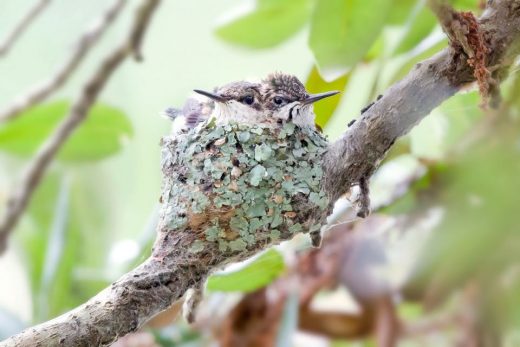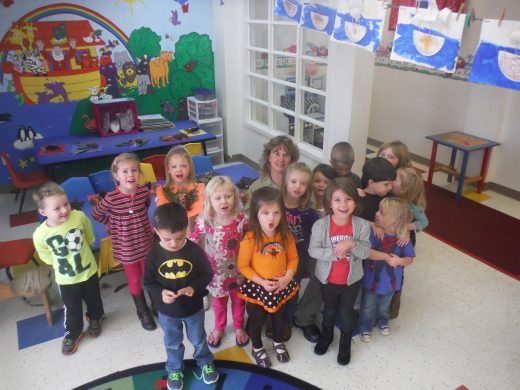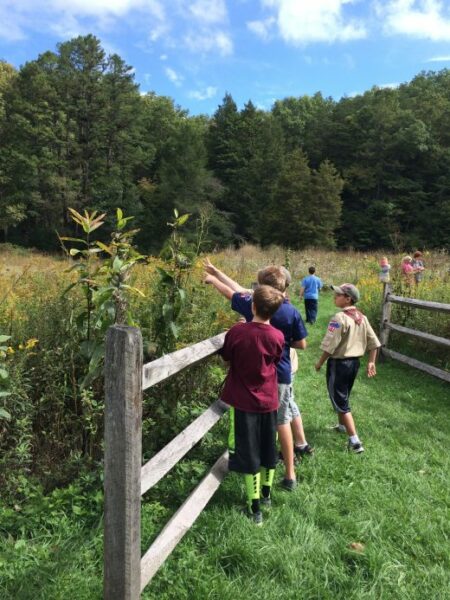By Ashley Peele

Hungry Mother State Park (CO VA State Parks)
Hungry Mother State Park chief ranger of visitor experience, Tanya Hall, has been leading kids on interpretive wildlife experiences for years. Atlasing for the VABBA2 brought her walks to a whole new level.
Hungry Mother State Park chief ranger of visitor experience, Tanya Hall, is leading a group of elementary-schoolers on an early-summer nature walk. Passing along a trail through a grassy area near the park’s 108-acre lake, they spot a male Ruby-throated hummingbird hovering above a patch of wild flowers. The bird’s speedy wings, iridescent green feathers and bright scarlet neck pique the kids’ interest. Whizzing toward a small oak, its aerial acrobatics have them awestruck.
Led by Hall, 48, the group tip-toes over and discovers a nest. The tiny, 2-inch abode makes quite an impression—whispers of ‘cute,’ ‘woah,’ and ‘aww’ abound. Hall takes the opportunity to explain the birds have migrated from Central America to Virginia, how males typically arrive a few weeks before females, how nests are woven from spider webs, grasses and plant fibers, lined with dandelion down or thistles, and camouflaged with moss, lichens, or dead leaves. The children are rapt.

Ruby-throated Hummingbird Nestlings (CO Bob Schamerhorn)
And Hall? She’s having an epiphany.
“I couldn’t believe how profoundly participating in the VABBA2 had impacted my approach to birds,” she says. Atlasing in the park since 2016, she now instinctively looks for breeding behavior. “Before, I might’ve been content just catching a glimpse of the hummingbird and pointing it out. Instead, we ventured off-trail and had a fantastic wildlife experience.”
Meanwhile, the kids were introduced to the Atlas: Hall had deputized them VABBA2 citizen scientists.
“And let me tell you, the idea of conducting ‘scientific research’ tickled them pink,” says Hall with a laugh. “Their observations became much more methodical and they asked tons of questions. It was a joy to see them get so interested and have so much fun.”
Though Hall and birding go way back, she says she “didn’t really get serious about it” until she volunteered for the VABBA2.
“Which is ironic, because it was birding that inspired me to switch college majors and pursue a career in environmental science in the first place,” says Hall.
Growing up on a hobby farm in Springfield, Ohio, she helped her father raise sheep and pigs, soybeans, corn and a home vegetable garden. As a child, she loved tending livestock and growing plants. The interest carried her to Morehead State University, an acclaimed agricultural school in Kentucky. There, she signed up for an ornithology elective as a sophomore.
“We’d go on hikes through various habitats with the professor pointing out birds and telling us their backgrounds and characteristics,” says Hall. “It was incredible how much he noticed. The experiences introduced me to a new way of interacting with nature and the outdoors.”
The affect was so great, Hall chose to pursue a degree in ecology. Graduating, she worked at various National Parks in Kentucky and southwestern Virginia, where she helped implement and develop educational programming—particularly for young kids. Though she carried an Audubon guidebook in her glovebox and kept one by the kitchen window at home, birding remained a casual pleasure.
“Working at parks, I met some really amazing birders,” says Hall. “But while I often tagged along on trips, I was mainly piggy-backing off their knowledge. I enjoyed myself, but wasn’t super active about getting better.”
Life got busier when Hall married and became a mother. Switching gears, she took work at a Marion-area preschool around 2005.
“I wanted to be close to my kids, but continue to work in an educational capacity,” says Hall. Teaching and developing nature-oriented programming for her children’s preschool fit the bill. Meanwhile, she worked part-time at the Blue Ridge Job Corps Center, mentoring at-risk youth. “We were constantly getting outside, going on walks, and discussing what we saw,” says Hall. “That was my primary focus: Trying to help kids develop a relationship with the natural world.”

Tanya and students
When her two children—now 10 and 14—got older, Hall again looked for work in state and national parks. She joined the team at Hungry Mother around 2012.
“Parks and wild spaces are my passion,” she says. “I loved working with preschoolers and being close to my kids, but I was very, very happy to get back to doing what I love.”
Hall learned about the VABBA2 in 2015. With its launch coinciding with the park’s 80th anniversary, Region 7 coordinator Steven Hopp inquired about leading introductory workshops at the Discovery Center. By the end of the conversation, Hall had partnered with Hopp for programming and committed to volunteer in a priority block overlapping the park.
“I got so excited,” she says. The project was ideal for showcasing how scientists collect information in the field and explaining how the data gets put to work. Hall quickly integrated the VABBA2 into visits by local schools. “When you take kids out and show them a bird and describe the behaviors they’re seeing, that sticks,” she says. It’s especially true for breeding and nesting activity. “In my experience, active learning trumps a classroom lecture every time—it’s direct engagement that sparks intellectual curiosity. That gets them interested and opens the door to talking about the more conceptual stuff.”
On a personal level, Hall says birding with the VABBA2 has led to greater intimacy with park environs. Professionally, it’s been an unexpected workforce development opportunity.
“Atlasing required me to learn more about avian behavior and interact with the park in a new and different way,” she says. “I’ve had to really immerse myself in habitats and pay close attention to what these birds are doing.” In doing so, she’s inspired interest in others. “Colleagues get curious and, when I tell them what I’m doing, they want to help out too. Then they go and tell others about the Atlas. And that’s created a really neat domino-effect.”
Overall, Hall says the VABBA2’s impact has been astounding.

Students explore HMSP
“Participating in this project has been profoundly positive, both for myself and this park,” she says. Seeing a kid’s face light up when she spots a bird working on a nest is one thing. But telling her she’s helping collect data for a scientific project of monumental importance? “That pushes the experience over the top. As an educator, it’s been an incredible learning tool.”
BIRDING HOTSPOTS
Working in one of Virginia’s most beautiful state parks has its benefits. For one, the job description entails becoming intimately familiar with the area’s best and wildest spots. Here, Hall shares some of her favorites.
The Lake Trail — Starting from the Hungry Mother State Park Boat Ramp, pursue the 5.7-mile loop trail around the eponymous 108-acre lake through a slew of cool and varied habitats. Enjoy feeder streams and creeks, wetlands, shady rhododendron thickets, and climb through dense forest to dry, isolated ridgelines. In route, you’ll catch plenty of views.
Clyburn Ridge Loop Trail —This awesome 4-miler begins at the trailhead directly across from Camp Burson and offers both unique terrain and sweet views of Hungry Mother Lake. Though it starts at an elevation of 2,215 feet and follows the high ridgeline, expect ample elevation change. About 1.5 miles in, you’re treated to an unusual grove of table-mountain pines. Though indigenous to Appalachia, the trees are typically found in points further west.
Molly’s Knob —A 1.9-mile multi-use trail carries visitors from the group lodge parking lot to Vista Trail, which leads to the park’s highest point, 3,270-foot Molly’s Knob. Climbing by way of heavy switchbacks through dense forest, you’ll pass through catawba and rosebay rhododendron thickets and grassy areas punctuated by wildflowers. At the summit, catch 180-degree overlooking Marion, Chilhowie and Mt. Rogers.
For a map and a complete list of HMSP trails, click HERE.
INTERESTED IN VISITING?
These great birder-oriented events are just around the corner:
Friday Bird Walks, launches March 22. Held each Friday into May, visitors are invited to join veteran birder and Master Naturalist, Randy Smith, for guided hikes through the park. Participants should gather at the Discovery Center by 8 a.m. For details, email Tanya Hall.
VABBA2 Block-Busting Rally, June 14-16.We’re thrilled to launch our 2019 Block-Busting Rally series at Hungry Mother State Park. Tell your friends and family, pack your coolers, gather your camping gear, and spend a weekend partying with the Atlas crew and crushing priority blocks. For details, check out the Atlas Events page. Look for updates and announcements via Facebook.


